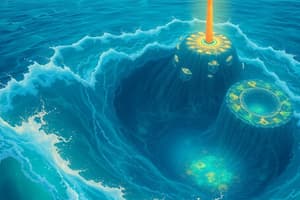Podcast
Questions and Answers
What is the main principle behind the operation of a two-basin tidal plant?
What is the main principle behind the operation of a two-basin tidal plant?
- Creating energy by harnessing solar power
- Generating electricity through wind energy
- Storing potential energy by filling an upper basin with water (correct)
- Using geothermal heat to produce electricity
During which phase does the potential energy stored in a tidal plant get released?
During which phase does the potential energy stored in a tidal plant get released?
- As the sluice gates are closed
- When the water levels are equal in both basins
- During the high tide cycle
- When water flows from the upper to lower basin (correct)
Which factor greatly influences the amount of potential energy available for generation in a tidal range power plant?
Which factor greatly influences the amount of potential energy available for generation in a tidal range power plant?
- The tidal range between high tide and low tide (correct)
- The temperature of the water in the basins
- The type of turbines used
- The geographical location of the plant
What is the role of sluice gates in a tidal barrage?
What is the role of sluice gates in a tidal barrage?
What distinguishes Closed-Cycle OTEC from Open-Cycle OTEC?
What distinguishes Closed-Cycle OTEC from Open-Cycle OTEC?
Which of the following is NOT an advantage of OTEC?
Which of the following is NOT an advantage of OTEC?
What element in the operation of a tidal power plant converts mechanical energy into electrical energy?
What element in the operation of a tidal power plant converts mechanical energy into electrical energy?
Which of the following factors does NOT impact the power developed by a tidal range power plant?
Which of the following factors does NOT impact the power developed by a tidal range power plant?
How does the turbined water flow contribute to electricity generation in a tidal barrage?
How does the turbined water flow contribute to electricity generation in a tidal barrage?
What primary feature of ocean thermal energy conversion systems allows them to produce power continuously?
What primary feature of ocean thermal energy conversion systems allows them to produce power continuously?
What principle do tidal stream generators operate on?
What principle do tidal stream generators operate on?
Which type of tidal plant is characterized by exploiting differences in water levels between high and low tides?
Which type of tidal plant is characterized by exploiting differences in water levels between high and low tides?
What is one advantage of tidal stream generators?
What is one advantage of tidal stream generators?
How do tidal kite systems generate electricity?
How do tidal kite systems generate electricity?
What is a defining feature of two basin tidal power plants?
What is a defining feature of two basin tidal power plants?
What operation occurs during high tide in a tidal range power plant?
What operation occurs during high tide in a tidal range power plant?
Which of the following types of tidal power plants has a higher potential for energy generation due to a large tidal range?
Which of the following types of tidal power plants has a higher potential for energy generation due to a large tidal range?
What type of tidal plant uses tethered underwater kites?
What type of tidal plant uses tethered underwater kites?
Which of the following is NOT an advantage of tidal energy?
Which of the following is NOT an advantage of tidal energy?
Which type of tidal plant has to consider the movement of water and currents to effectively generate energy?
Which type of tidal plant has to consider the movement of water and currents to effectively generate energy?
What is one of the main challenges faced by OTEC systems?
What is one of the main challenges faced by OTEC systems?
In which regions is OTEC most effective?
In which regions is OTEC most effective?
What fluid is commonly used in OTEC systems for vaporization?
What fluid is commonly used in OTEC systems for vaporization?
What occurs in the Evaporator of an Open Cycle OTEC system?
What occurs in the Evaporator of an Open Cycle OTEC system?
What is a key difference between Open Cycle and Closed Cycle OTEC systems?
What is a key difference between Open Cycle and Closed Cycle OTEC systems?
What happens to the vaporized fluid in the OTEC system after it passes through the turbine?
What happens to the vaporized fluid in the OTEC system after it passes through the turbine?
What is one of the engineering challenges associated with OTEC systems?
What is one of the engineering challenges associated with OTEC systems?
What is the purpose of the Condenser in an OTEC system?
What is the purpose of the Condenser in an OTEC system?
What factor contributes to the limited power density of OTEC systems?
What factor contributes to the limited power density of OTEC systems?
What is a common disadvantage of both Open and Closed Cycle OTEC systems?
What is a common disadvantage of both Open and Closed Cycle OTEC systems?
What happens to the stored potential energy in the upper basin during low tide in a two-basin tidal plant?
What happens to the stored potential energy in the upper basin during low tide in a two-basin tidal plant?
Which of the following factors does NOT influence the power output of a tidal range power plant?
Which of the following factors does NOT influence the power output of a tidal range power plant?
What role does the warm surface water play in the Ocean Thermal Energy Conversion (OTEC) process?
What role does the warm surface water play in the Ocean Thermal Energy Conversion (OTEC) process?
Which of the following is a characteristic of tidal barrage power plants?
Which of the following is a characteristic of tidal barrage power plants?
Which statement accurately describes the ecological considerations of tidal power plants?
Which statement accurately describes the ecological considerations of tidal power plants?
What is a key advantage of using Ocean Thermal Energy Conversion (OTEC)?
What is a key advantage of using Ocean Thermal Energy Conversion (OTEC)?
What happens to the vaporized fluid in a closed-cycle OTEC system after it drives the turbine?
What happens to the vaporized fluid in a closed-cycle OTEC system after it drives the turbine?
During what condition is the upper basin filled in a two-basin tidal plant?
During what condition is the upper basin filled in a two-basin tidal plant?
Which type of OTEC system utilizes seawater directly for power generation?
Which type of OTEC system utilizes seawater directly for power generation?
What is a key factor in determining the potential energy available for electricity generation in tidal power plants?
What is a key factor in determining the potential energy available for electricity generation in tidal power plants?
What is the primary feature of single basin tidal plants?
What is the primary feature of single basin tidal plants?
How do tidal stream generators convert tidal energy into electricity?
How do tidal stream generators convert tidal energy into electricity?
What is an advantage of tidal kite systems compared to traditional tidal plants?
What is an advantage of tidal kite systems compared to traditional tidal plants?
What distinguishes a tidal range power plant from other tidal plants?
What distinguishes a tidal range power plant from other tidal plants?
During which condition does a tidal range power plant generate electricity?
During which condition does a tidal range power plant generate electricity?
What mechanism is typically used to control water flow in a tidal range power plant?
What mechanism is typically used to control water flow in a tidal range power plant?
What process is utilized in tidal kite systems to generate electricity?
What process is utilized in tidal kite systems to generate electricity?
What is a common environmental benefit of tidal energy compared to fossil fuels?
What is a common environmental benefit of tidal energy compared to fossil fuels?
Which factor relates to the energy generation capacity of a tidal range power plant?
Which factor relates to the energy generation capacity of a tidal range power plant?
What is a significant operational aspect of tidal stream generators?
What is a significant operational aspect of tidal stream generators?
What is a primary challenge in the construction of OTEC plants?
What is a primary challenge in the construction of OTEC plants?
In which regions is Ocean Thermal Energy Conversion (OTEC) most effective?
In which regions is Ocean Thermal Energy Conversion (OTEC) most effective?
Which statement is true about Open Cycle OTEC systems?
Which statement is true about Open Cycle OTEC systems?
What causes the vaporized fluid in an Open Cycle OTEC system to drive a turbine?
What causes the vaporized fluid in an Open Cycle OTEC system to drive a turbine?
What significant engineering obstacle is associated with OTEC systems?
What significant engineering obstacle is associated with OTEC systems?
What is the function of the Condenser in an OTEC system?
What is the function of the Condenser in an OTEC system?
Which of the following best describes the key difference between Open Cycle and Closed Cycle OTEC systems?
Which of the following best describes the key difference between Open Cycle and Closed Cycle OTEC systems?
What is the impact of limited power density in OTEC systems?
What is the impact of limited power density in OTEC systems?
Which low-boiling-point fluid is commonly used in OTEC systems for vaporization?
Which low-boiling-point fluid is commonly used in OTEC systems for vaporization?
What advantage does Closed Cycle OTEC have over Open Cycle OTEC?
What advantage does Closed Cycle OTEC have over Open Cycle OTEC?
Flashcards
Tidal Power
Tidal Power
A form of hydropower using ocean tides to generate electricity
Single Basin Plant
Single Basin Plant
Tidal power plant harnessing the kinetic energy of tidal currents
Tidal Stream Generator
Tidal Stream Generator
A type of single basin plant that uses underwater turbines to capture tidal current energy.
Tidal Kite System
Tidal Kite System
Signup and view all the flashcards
Two Basin Plant
Two Basin Plant
Signup and view all the flashcards
Tidal Range Power Plant
Tidal Range Power Plant
Signup and view all the flashcards
Tidal Barrage
Tidal Barrage
Signup and view all the flashcards
Tidal Currents
Tidal Currents
Signup and view all the flashcards
Kinetic Energy
Kinetic Energy
Signup and view all the flashcards
Potential Energy
Potential Energy
Signup and view all the flashcards
Tidal Range Power Plant
Tidal Range Power Plant
Signup and view all the flashcards
Tidal Barrage
Tidal Barrage
Signup and view all the flashcards
Two-Basin Tidal Plant
Two-Basin Tidal Plant
Signup and view all the flashcards
Sluice Gates
Sluice Gates
Signup and view all the flashcards
Tidal Cycle
Tidal Cycle
Signup and view all the flashcards
Tidal Range
Tidal Range
Signup and view all the flashcards
OTEC
OTEC
Signup and view all the flashcards
Open-Cycle OTEC
Open-Cycle OTEC
Signup and view all the flashcards
Closed-Cycle OTEC
Closed-Cycle OTEC
Signup and view all the flashcards
Power Generation
Power Generation
Signup and view all the flashcards
OTEC System
OTEC System
Signup and view all the flashcards
High Initial Cost (OTEC)
High Initial Cost (OTEC)
Signup and view all the flashcards
Open Cycle OTEC
Open Cycle OTEC
Signup and view all the flashcards
Closed Cycle OTEC
Closed Cycle OTEC
Signup and view all the flashcards
Working Fluid (OTEC)
Working Fluid (OTEC)
Signup and view all the flashcards
Evaporation (OTEC)
Evaporation (OTEC)
Signup and view all the flashcards
Condensation (OTEC)
Condensation (OTEC)
Signup and view all the flashcards
Temperature Gradient (OTEC)
Temperature Gradient (OTEC)
Signup and view all the flashcards
Location-Specific (OTEC)
Location-Specific (OTEC)
Signup and view all the flashcards
Low Power Density (OTEC)
Low Power Density (OTEC)
Signup and view all the flashcards
Two-Basin Tidal Plant
Two-Basin Tidal Plant
Signup and view all the flashcards
Tidal Barrage
Tidal Barrage
Signup and view all the flashcards
Tidal Range
Tidal Range
Signup and view all the flashcards
Sluice Gates
Sluice Gates
Signup and view all the flashcards
OTEC
OTEC
Signup and view all the flashcards
Single Basin Tidal Plant
Single Basin Tidal Plant
Signup and view all the flashcards
Closed-Cycle OTEC
Closed-Cycle OTEC
Signup and view all the flashcards
Open-Cycle OTEC
Open-Cycle OTEC
Signup and view all the flashcards
Tidal Stream Generator
Tidal Stream Generator
Signup and view all the flashcards
Tidal Kite System
Tidal Kite System
Signup and view all the flashcards
Power Generation (Tidal)
Power Generation (Tidal)
Signup and view all the flashcards
Temperature Gradient (OTEC)
Temperature Gradient (OTEC)
Signup and view all the flashcards
Two Basin Tidal Plant
Two Basin Tidal Plant
Signup and view all the flashcards
Tidal Range Power Plant
Tidal Range Power Plant
Signup and view all the flashcards
Potential Energy (Tidal)
Potential Energy (Tidal)
Signup and view all the flashcards
Tidal Barrage
Tidal Barrage
Signup and view all the flashcards
Tidal Currents
Tidal Currents
Signup and view all the flashcards
Kinetic Energy
Kinetic Energy
Signup and view all the flashcards
Potential Energy
Potential Energy
Signup and view all the flashcards
Tidal Range
Tidal Range
Signup and view all the flashcards
OTEC
OTEC
Signup and view all the flashcards
Open Cycle OTEC
Open Cycle OTEC
Signup and view all the flashcards
Closed Cycle OTEC
Closed Cycle OTEC
Signup and view all the flashcards
High Initial Cost (OTEC)
High Initial Cost (OTEC)
Signup and view all the flashcards
Location-Specific (OTEC)
Location-Specific (OTEC)
Signup and view all the flashcards
Low Power Density (OTEC)
Low Power Density (OTEC)
Signup and view all the flashcards
Evaporation (OTEC)
Evaporation (OTEC)
Signup and view all the flashcards
Condensation (OTEC)
Condensation (OTEC)
Signup and view all the flashcards
Working Fluid (OTEC)
Working Fluid (OTEC)
Signup and view all the flashcards
Temperature Gradient (OTEC)
Temperature Gradient (OTEC)
Signup and view all the flashcards





